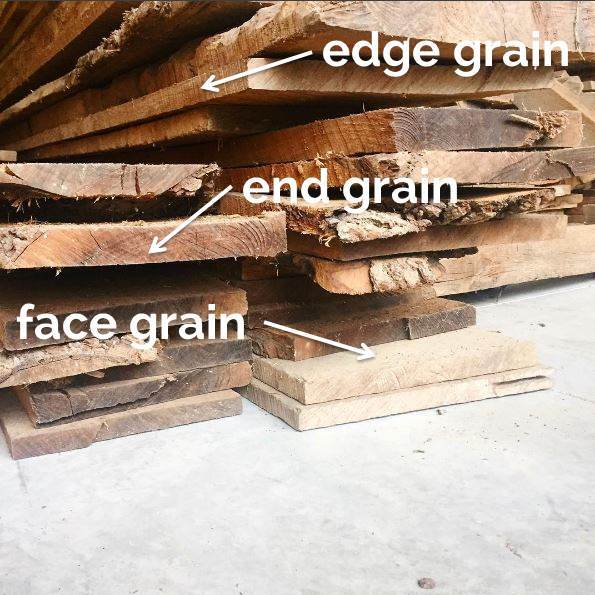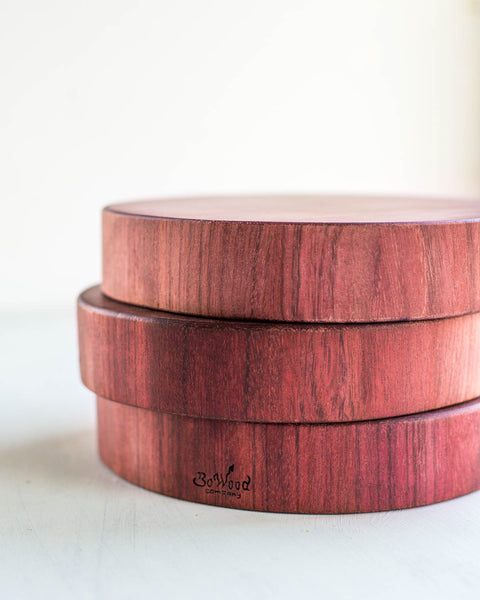My shopping cart
Your cart is currently empty.
Continue Shopping
You've got everything you need... your ingredients, and your knife, but now you need a cutting board. Though cutting boards are typically overlooked, there are a lot of things to consider when you choose the right cutting board for your kitchen. The look, the feel, and how long they last are important things to consider and we'll be covering the differences between edge grain versus end grain cutting boards and why you should choose one over the other. We'll also cover how to choose the correct size cutting board and which cutting jobs are done best with which size board.

Yes, we all know that wood comes from a tree but the really important part is how they saw the lumber. Trees are typically cut into large planks which are then cut into smaller strips of lumber. When you look at a typical piece of lumber, it has three distinct sides. The face grain, which is typically measured as the width of the board, the edge grain is usually what's measured as the thickness and the end grain which is the two ends of the board. The end grain is usually more distinctive and where you can see the growth rings of the tree. This is where you get the definition of either an edge grain or end grain cutting board.

One of the downsides to an edge grain board is that as you use it over time they do more easily show scratch and knife marks, and cuts can become permanent. The wood surface can also be too durable and can dull knives faster than end grain (a visual lesson on this later). Though edge grain boards are vulnerable to scratching and scoring, you can keep them looking good by following our care instructions whether you just need to add a little oil or need to do a complete restoration of your board. At the end of the day, edge grain cutting boards are the sweet spot in the wooden cutting board category for price versus performance as they take fewer steps to make and are typically thinner and easier to store.
You might be wondering why you'd want to go through the extra work of making an end grain cutting board when we just talked about the advantages and cost effectiveness of edge grain boards, but end grain boards have one large advantage. With end grain cutting boards, the cut ends of the wood are able to absorb the sharp edges of your knife without dulling them. Remember when we said that one of the disadvantages of edge grain is that they show knife marks and are hard on your knives? End grain solves these problems. One of the other advantages over edge grain construction is the lack of splinters. Although it is fairly uncommon with a properly constructed edge grain cutting board, it is possible to have a piece splint off. This is virtually impossible with an end grain board due to the direction the wood fibers are facing. End grain boards are also typically thicker than edge grain which reduces the risk of warping and allows you to use more force when cutting without damaging your board. The only major downside to end grain boards is the price. They are typically much more expensive than other board types due to the amount of additional labor required to make. Since they contain many small pieces of wood as opposed to long strips they can take two to three times longer to make. With end grain boards you do also have to be more careful with keeping water away and keeping them oiled. The pores of the wood are exposed with end grain boards and thus can absorb more moisture so keeping them oiled is very important. We have a little visual lesson coming up below for you to see the difference, but for now, just know that end grain boards are the crème la crème of cutting boards with their sturdy construction and friendliness towards your knives.

If you think about the grain of the wood as the raw spaghetti noodles shown above we can give you a better visual indication of the differences between edge grain and end grain cutting boards. When you are cutting on an edge grain board, you are cutting across the grain or in this case the spaghetti and you can imagine that if we were to actually cut into it that it would leave score marks that would be hard to fix. When you're looking at the end grain cutting boards you are cutting into the bundle of the ends of the spaghetti noodles where the noodles spread apart and allow your knife to pass in between them. Once you remove your knife, the noodles return to their original position. This same thing is happening with these wood cutting boards. When you hear of an end grain cutting board being able to "self-heal" this is why. This is the preferred style of cutting board if you're a serious chef that doesn't want to have to sharpen your knives too often or if you want a board that will last for multiple decades.

There is also the International Union for the Conservation of Nature (IUCN) which identifies, maintains, and publishes a “red list” of tree species that are in danger. You are probably familiar with their classifications: critically endangered, endangered, and vulnerable. We source our exotic hardwoods from a lumber mill who's owners have very high standards. For about six weeks of each year, they travel the world, visiting the sawmills that provide them with lumber and working with the millworkers to cut it to their specifications. Once that lumber then makes it to them, it’s kiln-dried and stored. We work very hard to make sure that all cutting boards sold on bowoodco.com are from sources that provide certified sustainable or renewable woods. It is important when considering a cutting board to think about the environmental ramifications, especially if it is made from a type of wood that you are unfamiliar with.

When it comes to looking at sanitation, we have to mention plastic cutting boards because many people believe that since you can wash them in the dishwasher (unlike wood) then it is a safer, more sanitary option. The USDA does lean towards recommending plastic cutting boards, but in the research study Plastic and Wooden Cutting Boards by Dean O. Cliver, Ph.D. of UC Davis, they noted that “the U.S. Department of Agriculture told us they had no scientific evidence to support their recommendation of using plastic, rather than wooden cutting boards”. Yes, plastic may seem like a very suitable option with its non-porous material that can't absorb liquids, but with use the surface of the plastic scores. This surface continues to get rougher and rougher and becomes extremely difficult to clean, even running through the dishwasher. In another study conducted at the University of Wisconsin (also by Dr. Cliver), they tested bacteria known to produce food poisoning – Salmonella, Listeria and enterohemorrhagic Escherichia coli. These bacteria were placed on cutting boards made from various wood and plastic types and all of the wood cutting boards outperformed their plastic counterparts. They found that when the plastic scores and gets cut, it allows for multiple places for bacteria to hide and grow, but with wood, these scientists found that three minutes after contaminating a board that 99.9% of the bacteria on the wooden boards had died, while the bacteria on the plastic boards did not. When stored at room temperature overnight the bacteria on the plastic board actually increased where the wood did not be found with any bacteria on it. Basically, the pores in the wood allow for the bacteria to penetrate where they become trapped, suffocate and die, proving that wood cutting boards are a much more sanitary option overall.

Ultimately, there are a number of reasons why you'd want to pick one board over another but the choice is yours. Whether your main consideration is the look, the feel, the durability or the price, we have a board that suits your needs. Click here to check out all of the cutting boards we offer.